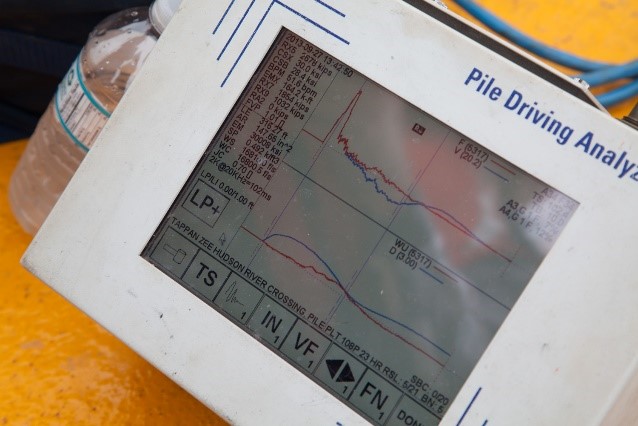
The Pile Driving Analyzer calculates pile strength or capacity as the steel-pipe piles are being driven into the riverbed.
The New NY Bridge is designed to last 100 years without the need for major structural repairs. Such impressive reliability and longevity can only be achieved with a solid foundation in place. That foundation is actually a series of massive steel pipes and “H” shaped steel driven deep into the subsoil of the river bottom. These “piles” will enable the structure to be supported by rock found hundreds of feet below the water’s surface and by the friction between the walls of the piles and the surrounding soil. In the world of infrastructure construction, piles are the most common type of support for large bridges.
The new bridge will be supported by a combination of deep foundations consisting of driven steel-pipe piles ranging from 36 to 72 inches in diameter, H-piles, and drilled shafts. The right kind of pile for bridge support depends on several factors, including geology, soil conditions, available equipment, and maintenance requirements. Because of the irregular depth of bedrock and the various consistencies of the soil beneath the lower Hudson River, the New NY Bridge will primarily be supported by concrete-filled, steel-pipe piles.
Before We Build, We Test
To ensure that the network of foundation piles can sustain the weight of the bridge (static loads), the weight and vibrations of vehicles crossing the bridge (live loads), and the impact of wind, tide, and water current (lateral loads), TZC has completed a series of dynamic and static pile-load testing operations. Some of these tests determined the horizontal capability of the piles (lateral tests), and others examined the vertical or weight-bearing capacity (static tests) of the underlying soils and bedrock in order to confirm that a given pier design is structurally right for the job. Dynamic testing uses sensors that are attached to a pile. Data collected from these sensors during driving is sent to an analyzer where pile strength, or “capacity,” can be calculated instantly in the field. In static pile testing, a test pile is driven, and then weight is applied to the pile to prove the capacity of the pile support.
How Are the Tests Done?
During the ongoing pile-load test phase, TZC crews execute numerous pile tests. These tests occurred at various points along the riverbed of the entire length of the bridge.
The test piles are incrementally loaded by hydraulic jacks pushing against a steel reaction frame. The reaction frame is used to receive the test load and then transfer the compression to the pile during the static pile load test. The maximum test load applied during the load test program exceeded 7 million pounds for the main span foundation piles.
What’s Next?
TZC has now begun the process of constructing permanent steel piles that will stand the test of time. These piles will be created for each specific pile location along the river bottom and will be brought to the construction site via barge. The majority of concrete used in the piles for the New NY Bridge will be made in a floating batch plant on site to reduce the need for delivery by trucks on local roads.
